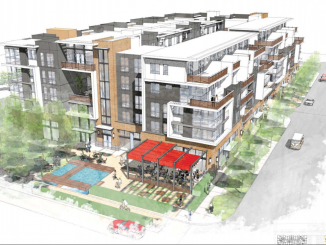BY ALLISON LEVITSKY
Daily Post Staff Writer
If Senate Bill 50 passes, a developer building a four-story apartment building in Menlo Park would net 3.5 times more profit than would a developer building a similar building in East Oakland’s Fruitvale neighborhood, according to a new UC-Berkeley report on state Sen. Scott Wiener’s housing bill.
SB50 would relax height, density and parking restrictions on residential development in “jobs-rich” areas like Palo Alto and within a half-mile of a transit station.
But, the report finds, zoning restrictions aren’t the only thing keeping developers from building large apartment buildings.
In some cases, it’s that the available lots are too small or the profit margins are too small, according to the report “Up-zoning Under SB50: The Influence of Local Conditions on the Potential for New Supply.”
In the report from Berkeley’s Terner Center for Housing Innovation and the Urban Displacement Project, graduate student researcher Jared Nolan compares the potential impacts of SB50 on the areas around transit stations in Menlo Park, Fruitvale and the Silver Lake and Boyle Heights neighborhoods in Los Angeles.
The four neighborhoods represent three different types of communities: Menlo Park is “low-density/high-income,” Fruitvale and Boyle Heights are “low-density/low-income” and Silver Lake is “low-density/diverse.”
Market differences are among the factors that Nolan finds can impact SB50’s effect on housing development.
40% profit margin
In Menlo Park, he writes, a developer would net a 40.8% profit margin on a 12-unit, $12.3 million apartment building that would cost $7.3 million to build.
In Fruitvale, a similarly sized building would be valued at $6.2 million and just barely pencil out for a developer.
At a $5.4 million total cost for the building and $307,594 in profit, that is about 25% less than what the Menlo Park developer would make.
The Fruitvale building would likely net a profit margin of 11.6%, a fraction of what could be earned in Menlo Park.
And if the developers included the two subsidized units required by SB50, the Fruitvale project wouldn’t be profitable.
The Menlo Park building would have a profit margin of 28.3%, while the Fruitvale building would be 6.1% in the red.
SB50 does, however, allow developers to pay a fee for affordable housing on smaller projects like the 12-unit building given in the example.
Nolan also finds that most lots near the transit stations in all four areas are sized for single-family homes, which means they may accommodate buildings of up to 12 units, but not much denser.
Potential for housing development
Menlo Park, however, had the most “underutilized” residential lots larger than 5,000 square feet. Of the 785 lots near the Caltrain station, 55% were found to be “underutilized,” meaning it has more than 5,000 square feet that is not occupied by a building.
Five thousand square feet is around the smallest footprint that can accommodate a four- to five-story building, Nolan writes.
This likely means that Menlo Park may provide more development opportunity than Fruitvale or Boyle Heights.
Nolan also notes that cities “resistant to new housing” could still limit new developments by imposing other restrictions on what is built on a lot. SB50 on its own does not remove all the constraints to development on a given lot.
Gentrification
Another factor to consider is the impact of SB50’s gentrification protections. The bill would prohibit tearing down buildings that are affordable or have been occupied by renters in the previous seven years.
Communities deemed “sensitive” to gentrification would also get some extra time to develop a plan before SB50 is implemented.
Nolan doesn’t address which communities would be considered “jobs-rich” under SB50, which would extend the zoning changes beyond areas within a half-mile of transit stops.




Hightech and other corporations also stand to benefit from SB 50 and like bills. They want more and cheaper housing for their current and planned employees. The more housing, the lower the market salary and other compensation. Plus, the more employees, the more profit for the corporation.